Islands and Coral Reefs
by Devender
0 2398
A piece of land that is surrounded by waters from all sides is known as Island. An island may occur individually or in groups.
Islands & Coral Reefs
Islands can be classified into two types that are -
- Continental islands
- Oceanic islands
- These islands were once part of the mainland
- These got detached from the mainland may be because of a shallow lagoon or deep channels, due to subsidence of some part of the land, or a rise in sea level
- Their connection with the mainland can be traced by the similar physical structure, flora, and fauna on both sides
- Greenland, the largest island has the same material as the adjacent North American continent
- They are separated by a shallow and narrow sea
- Their remoteness from different trading centres is the reason why these islands are sparsely populated
- Some of these islands provide useful stops to aeroplanes and ocean streamers
- Volcanic Islands
- Coral Islands
- Coral Reefs
- Polyps have a hard outer skeleton made of calcium
- Their limy skeletons are cemented into coralline limestone when they die
- The reefs grow best in warm, shallow, clear, sunny, and moving water
- They grow very slowly
- Favorable conditions for Coral Reefs
- The depth of the water should not exceed 180 feet or 30 fathom
- Beyond this range, sunlight is too faint for photosynthesis to take place
- The water should be free from sediments and saltish
- Coral Reefs survive best in moving ocean waters well away from the silty coasts & best developed on the seaward sides of the reef
- They form the border between the shoreline and surrounding islands
- Narrow, shallow lagoons separate it from the shore
- These reefs can be a mile wide
- These reefs can be partially submerged and lie above the water level
- Little vegetation is possible here as sand can get accumulated
- These reefs have narrow gaps at several places
- Water from the enclosed lagoon returns to the open surface from these gaps
- These gaps are also a medium for ships entering and leaving the lagoon
- These are generally oval or circular in shape
- They have an open lagoon in the center
- Darwin's Theory
- The outward side of the coral reefs grows the fastest
- The outward side feeds on the plankton that ocean currents bring
- On the inward or landward side, the oceanic plankton is very less as the water is very still
- Therefore, the reef on the inward side was unable to grow fast enough to keep up with the rising sea levels and eventually gets drowned
- Hence, a lagoon is formed between the reef and the land
- Daly’s Glacial Control theory
- He believed that coral growth didn't take place during the ice age as the water was too cold
- The lands were lower gradually as marine erosion was able to attack in the absence of a coral barrier
- The fringing reefs were supported by the narrow platforms
- The barrier reefs were supported by the broad platforms
- The isolated platforms supported the formation of Atolls
1 Continental Islands
These are basically parts of the continental shelf that are unsubmerged and are entirely surrounded by water. Many of the larger islands in the world are of this type.
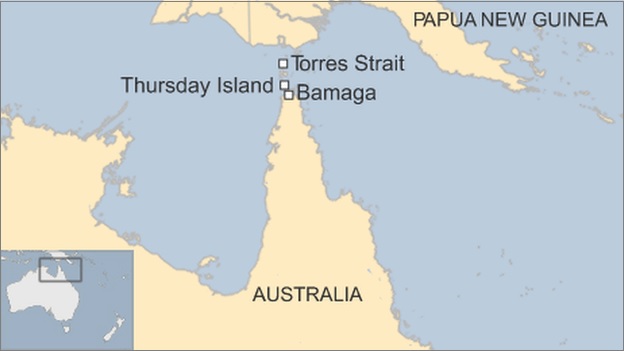
The second-largest island in the world, New Guinea is also a part of the Australian continental platform. It is separated by a very shallow and narrow Torres Strait. The continental islands can appear as individual islands, island groups, or island arcs.
2 Oceanic Islands
These islands are generally smaller and are found in the midst of oceans. They do not have any connection with the mainland so the flora and fauna of these islands are unrelated to the continents.
These islands can be further classified into two subcategories -
Volcanic islands are formed where the topmost part of the cone of the volcano rises from the ocean bed above sea level. The lava accumulates to enormous thickness until it finally protrudes above the ocean surface rising to a great height above the ocean surface.
For example - Islands of Hawaii
The Coral islands are lower and emerge just above the water surface. These islands are formed by the coral animals of various species and are found both near the shores of the mainland and in the midst of oceans.
In tropical seas, various kinds of coral animals & marine organisms such as coral polyps, calcareous algae, shell-forming creatures & lime-secreting plants live in large colonies. These creatures are tiny in size they have a great ability to secrete calcium carbonate within their tiny cells. This will give rise to a particular type of marine landform.
The coral reefs are made up of tiny animals known as polyps. These animals stay fixed in one place and are the main structure of the reef.
They grow around 0.3 cm to 10 cm per year and the reefs we see today have been growing from over 5000 to 10000 years.

The Coral Reefs thrive well only in warmer tropical seas, with water temp. not falling below 20 Degree C. They do not flourish in cold currents. This is why coral reefs are generally absent on the western coast of the continent.
Types of Coral Reefs
There are basically 3 different types of coral reefs.
1 Fringing Reefs:
Fringing Reefs are the most common type of reef in the world. It develops toward the ocean straightforwardly from the shore.
The slope of these reefs is steeply down towards the seaward side to the depth of around 100 feet. These reefs lie just above the level of low water.
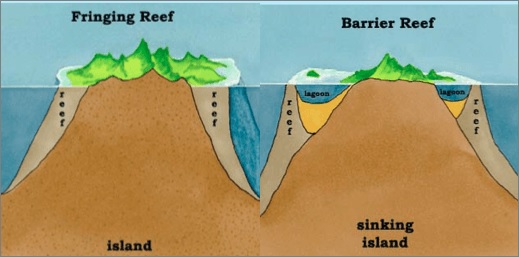
2 Barrier Reefs:
These reefs are similar to the fringing reefs as they also border a shoreline. These reefs are also parallel to the coastline. The difference between the two is that barrier reefs are separated by much deeper and wider lagoons.
3 Atolls:
An atoll is formed when a fringing reef continuously grows upward from a volcanic island that is entirely below sea level.
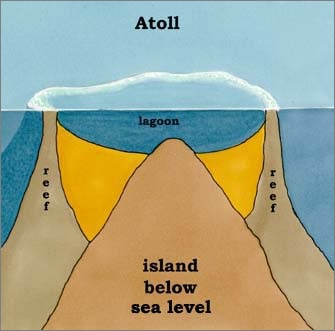
Theories of Coral Reefs Origin
He believed that all the coral reefs began as fringing reefs. These reefs start growing around an Island or the topmost portion of an extinct volcano which is above the ocean bed.
Due to the rising sea levels over millions of years, the volcano sunk lower into the sea but the coral keeps growing upward to stay in touch with the sunlight at the sea surface.
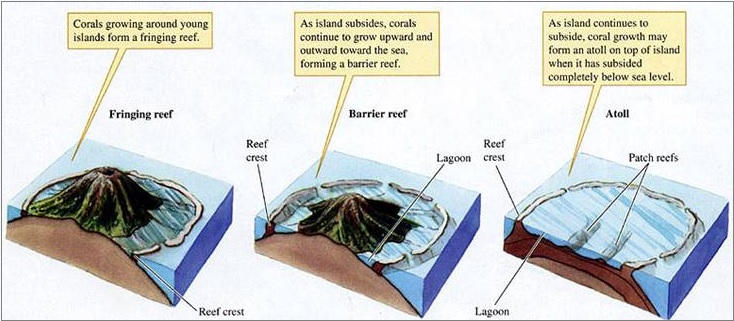
This results in the characteristics of a barrier reef and when the land of the volcano is completely submerged underwater, only the outer ring of the reef can be seen forming an atoll.
Therefore, the position of a former island is marked by the atoll and the lagoons that it contains are generally shallow.
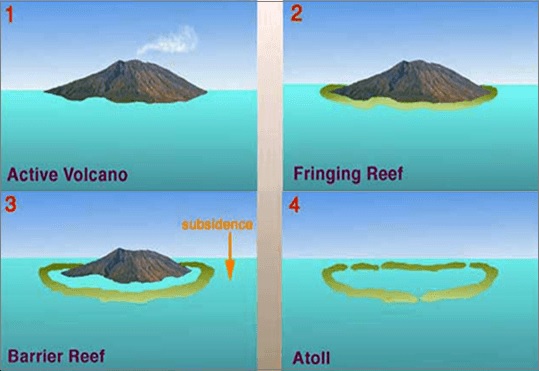
Daly found a close relationship between glaciation and the development of coral reefs. According to him, the subsidence of the sea level is caused by Pleistocene glaciation.
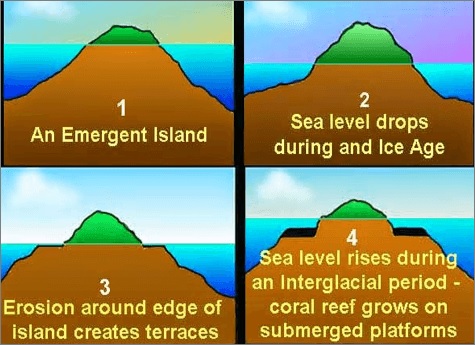
The ice sheets started melting when the climate grew warmer. It rose the sea level which submerged the lower islands forming wave platforms. On these wave platforms, the corals started to grow upward at a rate of a foot in a decade keeping with the pace of rising sea levels.

Share:







Comments
Waiting for your comments